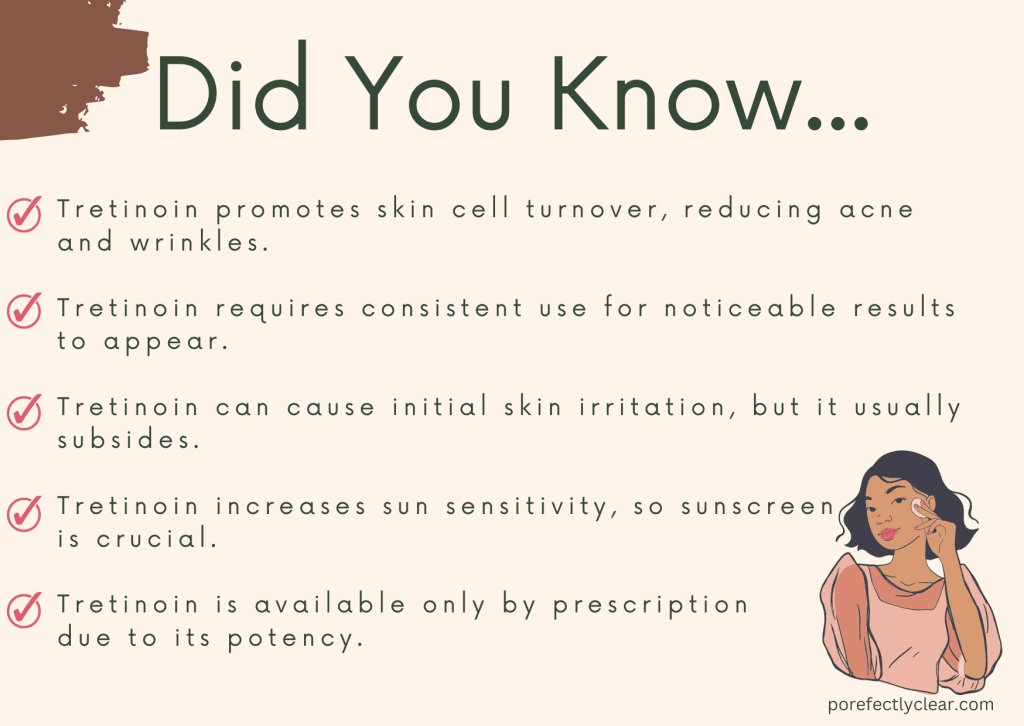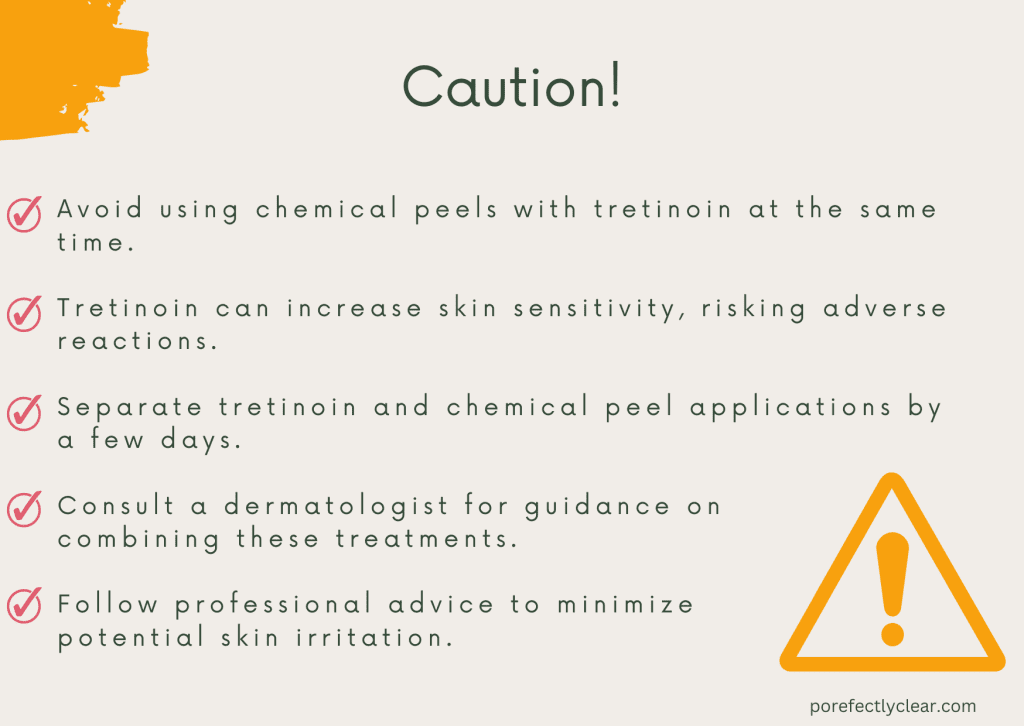Let’s embark on this journey to demystify the question: Is tretinoin an exfoliant? No, tretinoin is not classified as a traditional exfoliant. However, it can promote cell turnover and renewal in the skin, it works through different mechanisms compared to traditional exfoliants.
Skincare enthusiasts are well aware of the powerful effects of exfoliation on achieving a radiant and youthful complexion. Exfoliation is a crucial step in any skincare routine as it helps to remove dead skin cells, unclog pores, and promote cell turnover. It’s no wonder that exfoliants have become a staple in the pursuit of healthy and glowing skin.
Can Tretinoin Be Used As An Exfoliant?
Not necessarily, tretinoin is not classified as an exfoliant. While it can have exfoliating effects on the skin due to its ability to promote cell turnover, tretinoin primarily works by increasing cell renewal and stimulating collagen production.
Its main focus is on improving skin texture, reducing acne, and addressing signs of aging, rather than physically removing dead skin cells like traditional exfoliants do.
Before delving into the question of whether tretinoin is an exfoliant, it’s essential to clarify the concept of exfoliation itself.

What Does Tretinoin Do To Your Skin?
Cell Turnover and Renewal
As mentioned earlier, tretinoin accelerates the process of cell turnover and renewal in the skin. Promoting the rapid division and differentiation of skin cells, it helps to replace old and damaged cells with fresh, healthier ones.
This continuous renewal process contributes to a smoother complexion, improved skin texture, and a more youthful appearance.
Stimulates Collagen Production
Tretinoin is known to stimulate the production of collagen, a vital protein responsible for maintaining the skin’s structure and elasticity.
As we age, collagen production naturally declines, leading to the development of fine lines, wrinkles, and sagging skin. By boosting collagen synthesis, tretinoin can help to firm and tighten the skin, reducing the visible signs of aging.
Reduces Acne and Blemishes
Tretinoin is widely recognized for its effectiveness in treating acne and blemishes. It works by unclogging pores, reducing oil production, and preventing the formation of comedones (clogged hair follicles).
Also, tretinoin has anti-inflammatory properties that can help to calm existing acne lesions and promote healing, leading to clearer and healthier skin over time.
Improves Skin Texture
Due to its ability to promote cell turnover, increase collagen production, and address acne, tretinoin can significantly improve the overall texture and appearance of the skin.
It can minimize the appearance of fine lines, wrinkles, hyperpigmentation, and acne scars, resulting in a smoother, more even-toned complexion. With consistent use, tretinoin can contribute to a rejuvenated and youthful-looking appearance.
Understanding the impact of tretinoin on the skin underscores its valuable role in skincare. While it may not fit the conventional definition of an exfoliant, its unique mechanisms of action provide a range of benefits beyond what traditional exfoliants can offer.
The Role of Exfoliation in Skincare
Exfoliation refers to the process of removing dead skin cells from the outermost layer of the skin, known as the epidermis. It can be achieved through mechanical or chemical means.
The buildup of dead skin cells can lead to a dull complexion, clogged pores, and an uneven skin tone. Regular exfoliation plays a vital role in maintaining healthy skin by promoting cell turnover and revealing a fresher, smoother, and more radiant complexion.
Different Types of Exfoliants
- Physical Exfoliants: These include scrubbing particles or tools that physically slough off dead skin cells. Examples include sugar scrubs, brushes, loofahs, or exfoliating cleansers with granules.
- Chemical Exfoliants: These exfoliants use acids or enzymes to dissolve the bonds between dead skin cells, facilitating their removal. Common chemical exfoliants include alpha hydroxy acids (AHAs) like glycolic acid and lactic acid, beta hydroxy acids (BHAs) like salicylic acid, and enzymes like papain and bromelain.

Benefits of Regular Exfoliation
- Enhanced Skin Texture: Exfoliation promotes a smoother and softer skin texture by removing rough and flaky skin cells.
- Improved Skin Tone: By eliminating dead skin cells and unclogging pores, exfoliation helps to even out skin tone and reduce the appearance of hyperpigmentation, sunspots, and blemishes.
- Increased Absorption of Skincare Products: By removing the barrier of dead skin cells, exfoliation allows for better penetration of moisturizers, serums, and other skincare products, maximizing their effectiveness.
- Stimulated Collagen Production: Exfoliation can stimulate collagen synthesis, leading to improved skin elasticity and reducing signs of aging.
Combining Tretinoin with Exfoliants
Combining tretinoin with exfoliants can potentially enhance the exfoliation process and amplify the benefits for the skin. Exfoliants can help to further remove dead skin cells, unclog pores, and promote a smoother complexion.
However, it’s important to exercise caution when combining these two powerful skincare components, as improper use can lead to skin irritation, dryness, and sensitivity.
Recommendations for Safe Use
Before incorporating exfoliants into your skincare routine while using tretinoin, it’s advisable to consult a dermatologist. They can evaluate your skin type, assess its sensitivity, and provide personalized guidance on the most suitable exfoliants and their frequency of use.
If your dermatologist approves the combination, start by introducing exfoliants gradually. Begin with a lower concentration or frequency to allow your skin to acclimate. Monitor your skin’s response and adjust accordingly.
Conclusion
By promoting the shedding of old skin cells and stimulating collagen production, tretinoin contributes to a smoother complexion, improved texture, and reduced signs of aging.
When combining tretinoin with exfoliants, it is crucial to exercise caution and consult with a dermatologist. They can provide personalized advice based on your skin type, sensitivity, and specific needs.
Implementing exfoliation techniques, such as gentle chemical exfoliants or physical exfoliation tools, can further enhance the exfoliation process and address specific skin concerns.
However, it’s essential to strike a balance and avoid over-exfoliating, which can lead to skin irritation and dryness. Monitoring your skin’s response, adjusting the frequency and concentration of exfoliants, and prioritizing moisturization and sun protection are key factors in maintaining a healthy and balanced skincare routine.





